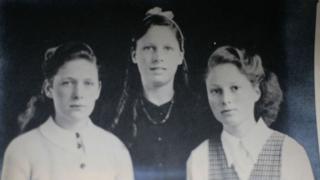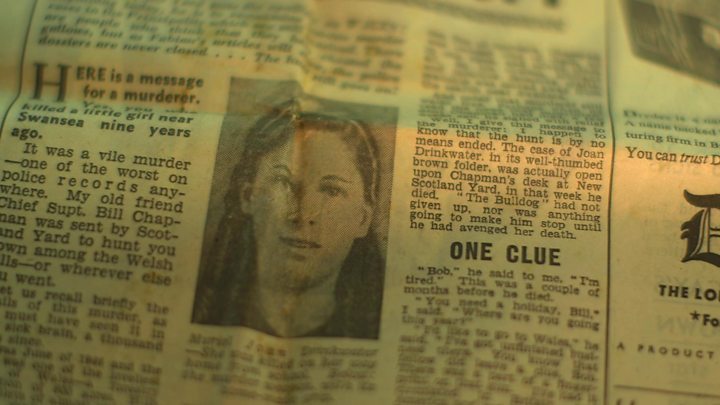 Image copyright
Drinkwater family photo
Image copyright
Drinkwater family photo
A schoolgirl's murder has gone unsolved since she was brutally slain more than 70 years ago. But a piece of forensic evidence - thought to be among the oldest such specimens in the world - may finally prove who killed her.
Twelve-year-old Muriel Drinkwater was singing as she walked along the mile-long path to her home after getting off a school bus.
Her mother Margaret watched from the house as the youngest of her four daughters went among the trees and disappeared from sight.
It was the last time her mother saw her alive.
The next day the child's body was found. Muriel had been brutally raped and shot twice.
Muriel's death in 1946, dubbed the Little Red Riding Hood Murder by the national press, could soon be solved.
The prime suspect is a convicted child killer who some suspect was also "Jack the Stripper", a man responsible murdering a string of women in London during the 1960s.
Thousands of men were questioned over the shocking death of Muriel, a schoolgirl at Penllergaer Grammar School on the outskirts of Swansea.
Posters featuring the weapon used and a description of a man wanted for questioning were circulated widely but yielded no results.
Despite the effort and resources ploughed into finding the killer, the inquiry remained unsolved.
But a vital piece of forensic evidence may finally lead police to the identity of Muriel's killer.
A semen stain found on Muriel's coat is thought to be one of the oldest pieces of crime scene evidence in the world.
It was discovered during a 2003 case review, and was used to rule out a boy seen passing Muriel minutes before she was attacked as a suspect.
It is understood South Wales Police are now looking into whether Harold Jones. who murdered two young girls in a town about 45 miles away, also killed Muriel.
Neil Milkins, a historian who has spent 12 years researching Muriel's murder, said: "Harold was a convicted double child murderer - suspected of being one of Britain's most notorious serial killers.
"His history is one of unspeakable violence and cruelty.
"He would have had no problem committing this murder."
Growing up in Abertillery in a poor family, Jones left school in his early teens and began work as a shop assistant.
But in February 1921, aged just 15, he lured eight-year-old Freda Burnell to a seed store behind the shop and killed her in a vicious attack.
He hid her body and dumped it in an alley during the night.
As the last person to see her alive, Jones was arrested and put on trial at Monmouth Assizes.
But local people believed he was being "fitted up" by the London detectives and campaigned for his release.
After being found not guilty and released, he was paraded through the town shoulder high by his supporters and presented with a gold watch.
Yet within days of his acquittal, he struck again.
This time it was Freda's friend, 11-year old Florence Little.
He lured her to his home, slit her throat, then hid her body in the attic.
Upon the discovery of her remains, Jones admitted both murders and was jailed for 20 years.
When he was released in 1941, he joined the army, serving in Libya before his military service ended in February 1946.
Muriel was murdered four months after he left the forces.
Mr Milkins said: "Just before he was released from prison, he told authorities he didn't want to lose the desire to kill and rape.
"So it seems to me, and also psychologists, he may have gone on to kill many more times.
"He was a psychopath, so calm and cool.
"It seemed he could kill someone, walk away, and talk to people with no nerves at all."

At the time of Muriel's killing, Jones lived in London but according to Mr Milkins, could have easily travelled to the Swansea area, which he was familiar with.
There is a school of thought he was also Jack the Stripper, a notorious killer who strangled six women in London in the 1960s.
Jones lived in the area at the time of the killings, and a 2018 investigation led by criminologist Prof David Wilson, named him as the prime suspect.
Jones later went on to have a daughter, who knew nothing of his crimes, and he led an "unassuming life" until his death from cancer in 1971.
As for the unsolved murder of Muriel, the BBC understands that police will be testing the DNA from the coat against that of Jones.
The age of the DNA makes the examination highly unusual, according to one expert.
Dr Jane Monckton Smith, a forensic criminologist who grew up near Muriel's home town, said: "Personally, I don't know anyone using a sample so old.
"It's amazing that we have come so far that we can extract a profile from it.
"From what I know, Harold Jones was a sexual sadist and from my limited knowledge, I think it's highly likely he is a good suspect in a number of murders."
For Muriel's niece, Margaret, an answer to her murder cannot come soon enough.
"It would be amazing to get a result," she said.
"I just hope they can make a clear identification of the suspect.
"Muriel was my aunt, and my mum and her had a very happy childhood on the farm.
"The murder of her little sister had a massive effect on my mother and family.
"Ideally, I would like to put it to rest, because it's an open case.
"We need justice for Muriel."